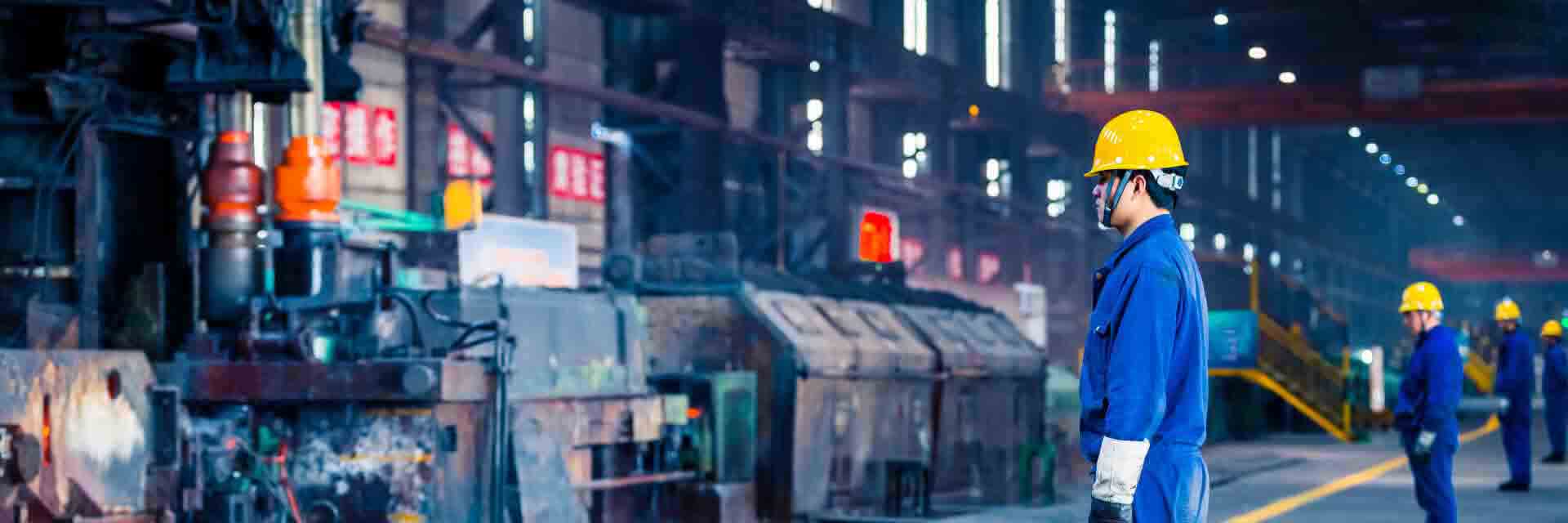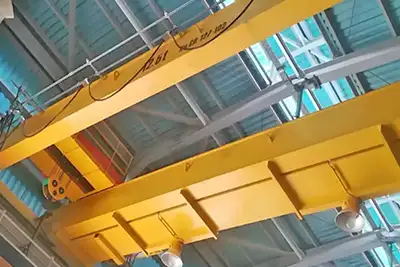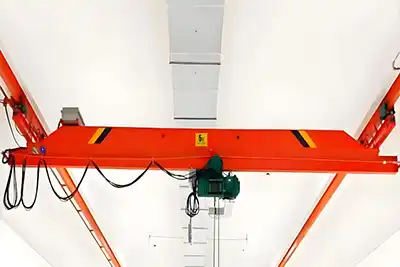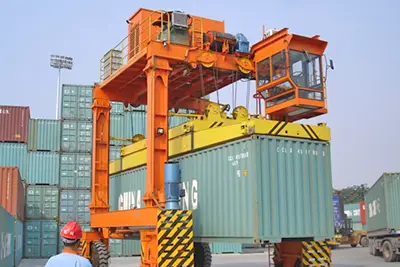ROI of Explosion-Proof Cranes in Hazardous Environments
Calculating ROI helps businesses assess long-term safety, compliance, and productivity benefits of explosion-proof cranes in hazardous work settings.
Introduction:Explosion-Proof Cranes: What They Are
Explosion-proof cranes are designed specifically for use in environments where there’s a risk of fire or explosion, such as chemical plants, oil refineries, or mining operations. They come equipped with special features to keep sparks, heat, or flames from igniting dangerous materials around them.
Key features include:
- Sealed electrical systems to prevent sparks
- Protective coatings to resist ignition
- Specially designed components to minimize fire hazards
These cranes allow industries to operate safely, handling heavy loads without the fear of an explosion. Without this specialized equipment, the risks are just too high to ignore.
Why ROI Is Crucial in Industrial Investments
ROI, or Return on Investment, is all about figuring out if the money you’re spending will pay off in the long run. For explosion-proof cranes, this isn’t just about the initial purchase price. It’s about what kind of value they’ll bring over time.
What ROI includes:
- The cost of the crane itself
- Savings on safety costs (fewer accidents = lower insurance)
- Less downtime because of accidents or equipment failures
- Meeting strict safety and regulatory standards
When you buy an explosion-proof crane, you want to make sure that the investment leads to long-term savings, reduced risks, and smoother operations. So, understanding ROI is essential to making the right choice.
Why Understanding ROI Matters in Hazardous Environments
In places where explosions or fires could happen at any moment, safety comes first. Explosion-proof cranes are designed to minimize risks, but they also come at a higher cost. That’s why understanding the ROI in hazardous environments is crucial.
Here’s why:
- High Stakes: Accidents in hazardous environments can lead to severe consequences, including injury or death.
- Costly Consequences: Regulatory fines, legal fees, and damaged reputation can cost a business far more than investing in the right equipment.
- Long-Term Gains: Explosion-proof cranes not only protect workers but also help ensure the business keeps running smoothly. The ROI reflects both the safety and productivity improvements these cranes bring.
At the end of the day, understanding ROI helps businesses make smarter choices. It’s not just about the price tag but about the bigger picture: safer workers, fewer accidents, and a more efficient operation.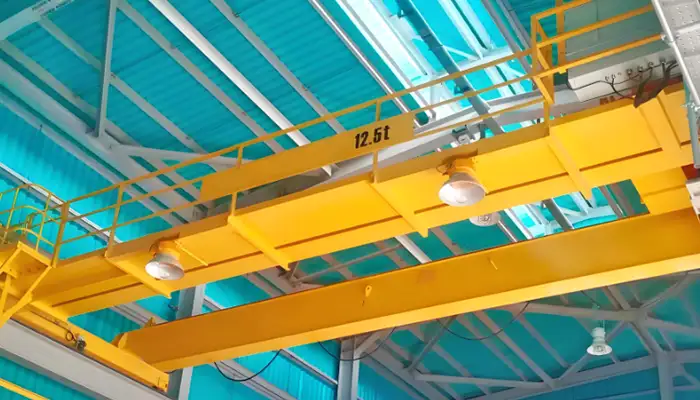
European style explosion proof bridge crane for sale
The Role of Explosion-Proof Cranes in Hazardous Work Environments
What Are Hazardous Work Environments?
Hazardous work environments are places where dangerous materials or conditions could lead to explosions or fires. These environments often have flammable gases, vapors, dust, or liquids present, making them extremely risky for regular equipment to operate safely.
Examples of hazardous environments include:
- Chemical plants: where chemicals may leak or react explosively
- Oil refineries: where flammable gases and vapors are a constant threat
- Mining operations: where dust and methane gas can lead to explosions
In these environments, standard cranes are not safe. Specialized equipment, like explosion-proof cranes, is essential for safe operation.
Safety and Regulatory Requirements
To ensure safety in hazardous environments, industries must comply with strict regulations. These standards exist to reduce the risk of accidents and protect both workers and equipment. Explosion-proof cranes are designed to meet these safety requirements and prevent ignition risks.
Common safety certifications and standards include:
- ATEX: A European directive that sets standards for equipment used in explosive atmospheres
- IECEx: An international certification system for electrical equipment used in explosive atmospheres
- NEC Class/Division: U.S. standards for electrical equipment used in hazardous locations
By meeting these regulations, explosion-proof cranes ensure that operations stay compliant, reducing the risk of accidents and helping companies avoid fines.
How Explosion-Proof Cranes Prevent Accidents
Explosion-proof cranes play a key role in preventing accidents in hazardous work environments. Their design is focused on eliminating ignition risks, which is crucial in settings where even a small spark can lead to disaster.
Here’s how explosion-proof cranes help prevent accidents:
- Sealed Electrical Systems: Prevent sparks or heat from escaping and igniting flammable gases or dust.
- Explosion-Proof Components: Specially designed parts are used to prevent any potential ignition source from reaching hazardous materials.
- Grounding and Bonding: Explosion-proof cranes are grounded to safely direct any electrical charges away from sensitive areas, preventing sparks.
- Built-In Overload Protection: Helps prevent accidents caused by lifting loads that are too heavy for the crane’s capacity.
These safety features ensure that cranes can operate in volatile conditions without triggering explosions, keeping both the workers and the facility safe.
Key Factors Affecting ROI for Explosion-Proof Cranes
Initial Investment Costs
When investing in explosion-proof cranes, the initial cost can be higher than purchasing standard cranes. The price difference comes from the specialized design and features needed for safe operation in hazardous environments.
Purchase Price vs. Standard Cranes
- Explosion-proof cranes: Due to the safety features, higher-quality materials, and stricter manufacturing standards, explosion-proof cranes typically cost more than standard cranes.
- Standard cranes: These are designed for regular environments and don’t have the safety features necessary to handle dangerous atmospheres. As a result, they’re cheaper but pose a higher risk when used in hazardous conditions.
While the upfront cost may be higher, explosion-proof cranes offer long-term savings through safer operations and reduced risks.
Customization for Hazardous Environments
Explosion-proof cranes often require customization to meet the specific needs of a hazardous work environment. This could involve:
- Special coatings or materials to prevent ignition
- Sealed electrical systems to avoid sparks
- Adjustments to crane components for increased durability
This customization adds to the initial cost but ensures the crane will perform safely and efficiently in high-risk areas.
Operational Costs
The operational costs of explosion-proof cranes go beyond the purchase price. You’ll want to consider the energy consumption and ongoing costs to run the equipment.
Energy Efficiency and Running Costs
Explosion-proof cranes are designed to work efficiently while ensuring safety. Over time, the energy efficiency of these cranes can make a significant difference in operational costs.
- Energy-efficient motors and optimized control systems can help reduce power consumption, making the crane cheaper to operate.
- Although energy-efficient cranes may come at a slightly higher price, they deliver better value over time by reducing utility costs.
Maintenance and Service Costs (Long-Term)
Like any heavy machinery, explosion-proof cranes require regular maintenance. The long-term costs include:
- Routine inspections: Ensuring the crane stays compliant with safety standards.
- Replacement of parts: Explosion-proof cranes often have more specialized parts, which can be more expensive to replace than standard crane components.
- Service costs: The complexity of these cranes may require specialized technicians for repairs and maintenance.
While maintenance can be costlier than standard cranes, it is crucial for ensuring the crane operates safely and continues to meet regulatory standards.
Safety and Compliance Costs
One of the biggest factors contributing to ROI is the cost of safety and compliance. Explosion-proof cranes help reduce the financial impact of safety violations and accidents, which can be much more expensive than the cost of the crane itself.
Avoiding Potential Fines and Shutdowns Due to Safety Violations
- Non-compliance penalties: If a business fails to meet safety standards, it can face hefty fines and potential shutdowns. Explosion-proof cranes help ensure compliance with safety regulations, reducing the risk of fines or operational halts.
- Avoiding legal costs: In the event of an accident, businesses may face expensive lawsuits. A crane that prevents accidents reduces the chances of costly legal battles.
Insurance Benefits from Reduced Risk
Explosion-proof cranes can help lower insurance premiums. By reducing the risk of accidents and ensuring safety, companies can benefit from:
- Lower premiums: Insurance companies may offer discounts for using explosion-proof equipment that minimizes risk.
- Reduced liability: Fewer accidents mean fewer claims, which can keep insurance rates down.
By investing in explosion-proof cranes, companies not only improve safety but can also save money on insurance and avoid expensive fines or shutdowns. These long-term savings are a key component of the ROI for explosion-proof cranes.
Calculating ROI for Explosion-Proof Cranes
Formula for ROI Calculation in Industrial Applications
Calculating ROI for explosion-proof cranes involves comparing the total benefits over time to the initial investment and ongoing costs. The basic formula for ROI is:
ROI = (Total Benefits - Total Costs) / Total Costs x 100
Where:
- Total Benefits include savings from reduced accidents, compliance with regulations, and improved efficiency.
- Total Costs include the crane’s initial purchase price, ongoing maintenance, and operational costs.
The result is expressed as a percentage that shows how much return you can expect for every dollar invested. The higher the percentage, the better the ROI.
Factors to Include in the Calculation
Several factors need to be considered when calculating ROI for explosion-proof cranes. These factors help paint a clear picture of both the direct and indirect returns on investment.
Crane Lifespan and Depreciation
- Lifespan: Explosion-proof cranes are built to last. The longer the crane lasts, the lower the depreciation cost per year. For example, if a crane costs $100,000 and lasts 20 years, the annual depreciation would be $5,000.
- Depreciation: Since explosion-proof cranes are an investment, it’s essential to account for depreciation, which reduces the crane’s value over time. Depreciation should be factored into your ROI calculation to reflect the true cost of the crane over its lifespan.
Reduced Downtime and Accident-Related Costs
Downtime is one of the most significant cost factors in any industrial environment, especially in hazardous work settings where accidents can lead to long delays or complete shutdowns.
- Accident-related costs: Explosion-proof cranes minimize the risk of accidents, which reduces the need for costly repairs, legal fees, and insurance claims.
- Reduced downtime: Safer operations mean fewer accidents and less unplanned downtime. For example, if an accident leads to two weeks of downtime every year, the cost of lost production could be substantial. An explosion-proof crane helps eliminate these risks, leading to more consistent uptime.
By reducing downtime, businesses can improve productivity and profitability. This should be factored into ROI by calculating the amount of time saved each year and the resulting revenue or cost savings.
Increased Productivity and Operational Efficiency
Explosion-proof cranes are not just safer; they are often more efficient than standard cranes in hazardous environments. This efficiency translates into increased productivity.
- Improved operational efficiency: Explosion-proof cranes can handle loads more effectively and quickly than non-explosive-rated cranes, speeding up processes.
- Higher output: With fewer delays and accidents, workers can perform tasks more efficiently, leading to higher output and potentially more revenue.
When calculating ROI, it’s essential to factor in how much increased productivity will contribute to your business’s bottom line. A crane that helps workers move materials faster and more safely adds measurable value.
Example of an ROI Calculation for a Typical Hazardous Work Environment
Let’s break down an example of how to calculate ROI for an explosion-proof crane in a chemical plant, where safety and compliance are top priorities.
Assumptions:
- Initial Purchase Price of Crane: $150,000
- Annual Maintenance and Operating Costs: $10,000
- Crane Lifespan: 20 years
- Depreciation: $150,000 ÷ 20 = $7,500 per year
- Accident-Related Costs (avoided): $50,000 per year (due to reduced accidents and downtime)
- Increased Productivity (savings): $20,000 per year (due to better efficiency and uptime)
ROI Calculation:
Total Costs:
- Initial Purchase Price: $150,000
- Annual Maintenance and Operating Costs (over 20 years): $10,000 × 20 = $200,000
- Total Costs over 20 years = $150,000 + $200,000 = $350,000
Total Benefits:
- Avoided Accident Costs (over 20 years): $50,000 × 20 = $1,000,000
- Increased Productivity (over 20 years): $20,000 × 20 = $400,000
- Total Benefits over 20 years = $1,000,000 + $400,000 = $1,400,000
ROI Calculation:
- ROI = (Total Benefits - Total Costs) ÷ Total Costs × 100
- ROI = ($1,400,000 - $350,000) ÷ $350,000 × 100
- ROI = $1,050,000 ÷ $350,000 × 100 = 300%
Interpretation:With a 300% ROI, for every $1 invested in the explosion-proof crane, the company gets $3 in return through cost savings, increased productivity, and reduced accident-related expenses. This example shows how the initial investment pays off well over time, making explosion-proof cranes a wise long-term investment for hazardous environments.
Benefits Beyond ROI: Long-Term Strategic Advantages
Enhanced Worker Safety
One of the biggest advantages of explosion-proof cranes is the enhanced worker safety they provide. In hazardous environments, ensuring that workers are safe from accidents and injuries is not just a legal requirement but also a moral obligation. These cranes are specifically designed to eliminate potential hazards that could lead to dangerous situations.
- Lower Accident Rates and Fewer Injuries
Explosion-proof cranes reduce the risk of accidents that could result in injuries or even fatalities. The safety features, such as spark-resistant components and sealed electrical systems, significantly lower the chances of ignition and explosion, making these cranes a critical part of safety measures. Over time, fewer accidents mean fewer workers’ compensation claims, lower insurance costs, and most importantly, a safer workplace. - Improved Employee Morale and Retention
Workers who feel safe at their job are more likely to be satisfied with their role and remain loyal to the company. Knowing that the company invests in equipment like explosion-proof cranes shows that the business prioritizes worker safety. This improves overall morale and helps with employee retention, reducing turnover and the costs associated with hiring and training new workers.
Regulatory Compliance
Explosion-proof cranes help businesses comply with stringent safety and environmental regulations. Meeting these standards is not just a legal necessity but also a strategic advantage in maintaining a good reputation in the market.
- Meeting Safety Standards
In hazardous environments, strict safety regulations (like ATEX, IECEx) govern equipment used to ensure that businesses operate safely and within the law. Explosion-proof cranes meet these standards, ensuring that businesses avoid regulatory violations. Staying compliant reduces the risk of fines and costly legal issues. - Improving Brand Reputation
A company’s commitment to safety and compliance can greatly enhance its reputation in the industry. Clients, partners, and regulators take notice when a company invests in equipment that ensures worker safety and environmental protection. This commitment helps to build trust and can even be a competitive advantage when bidding for contracts, particularly in industries that prioritize safety.
Increased Operational Efficiency
Beyond safety, explosion-proof cranes deliver operational benefits that impact the bottom line. These cranes help streamline operations, reduce costs, and improve productivity.
- Faster Load Handling and Reduced Downtime
Explosion-proof cranes are often more efficient than standard cranes in hazardous settings. Their specialized design allows them to handle loads more effectively, speeding up operations. Faster load handling means that production lines or operations run more smoothly, which reduces costly downtime and keeps the business running at full capacity. - Ability to Handle More Complex or Hazardous Tasks
Explosion-proof cranes are capable of handling complex and potentially dangerous tasks that regular cranes cannot. For example, in environments with volatile chemicals or gases, explosion-proof cranes can safely handle heavy loads that need to be moved quickly and efficiently, such as chemical containers or hazardous materials. This ability to perform complex tasks increases the range of operations a company can undertake, opening the door to more business opportunities and projects.
The combination of enhanced safety, regulatory compliance, and increased operational efficiency positions explosion-proof cranes as a valuable long-term investment that goes beyond just ROI. These cranes contribute to a safer, more productive, and more compliant operation, all of which support the overall success and growth of the business.
Case Studies
Success Stories of Industries Utilizing Explosion-Proof Cranes
Explosion-proof cranes have been successfully implemented in various industries, providing tangible safety and operational benefits. Here are some real-world examples of industries that have seen positive results:
- Chemical Industry
A major chemical plant in the U.S. invested in explosion-proof cranes to handle hazardous materials and chemicals. Before the upgrade, the plant experienced frequent downtime due to accidents involving standard cranes. After installing explosion-proof cranes, the plant saw a 40% reduction in downtime and a 50% decrease in workplace injuries over a two-year period. These improvements translated into greater operational efficiency and enhanced compliance with industry safety regulations. - Oil Refineries
An oil refinery in the Middle East faced significant challenges with the risk of fire and explosion in its processing units. After switching to explosion-proof cranes, the refinery reduced accidents involving flammable substances by over 60%. The cranes' ability to handle materials safely in explosive environments allowed for faster production cycles, contributing to an overall 15% increase in annual productivity. - Mining Operations
A mining company operating in a remote area invested in explosion-proof cranes to handle volatile mining chemicals and equipment in its processing facility. The investment led to a significant reduction in both accidents and the need for emergency response services, cutting costs by nearly $500,000 annually. The company also noted that employee morale improved as a result of the safer working conditions, leading to better retention rates.
ROI Results in Chemical, Oil, and Mining Industries
- Chemical Industry:
In a large chemical facility, the installation of explosion-proof cranes resulted in a 200% ROI within the first three years. Savings came from a combination of reduced accident-related costs, improved productivity, and compliance with new safety regulations. The plant was able to avoid fines for non-compliance, which would have been substantial without the investment in explosion-proof equipment. - Oil Refining:
For an oil refinery, the ROI from explosion-proof cranes was even higher. The plant experienced an ROI of 350% over five years, thanks to reduced downtime, fewer accidents, and higher throughput. The safety upgrades not only saved costs but also improved the refinery’s ability to meet stringent environmental standards. - Mining Operations:
In a mining operation, ROI was measured at 250% after four years. Much of the savings came from fewer accidents, which directly impacted the facility’s insurance premiums. Additionally, the ability to increase production due to reduced crane-related downtime made the investment highly profitable.
Potential Challenges in Achieving ROI
While the ROI of explosion-proof cranes can be substantial, there are potential challenges that businesses need to consider. These challenges can affect the overall profitability of the investment if not properly managed.
Upfront Costs and Financing Options
The initial investment for explosion-proof cranes is one of the most significant challenges. The price tag for these cranes can be much higher than standard cranes, especially when you factor in customization for hazardous environments. However, businesses can mitigate these costs by exploring different financing options:
- Leasing: Leasing explosion-proof cranes can allow businesses to spread out the upfront cost over time, making the investment more manageable.
- Financing Programs: Some crane manufacturers and financial institutions offer financing packages tailored to industrial businesses, making it easier to purchase and install the cranes without draining cash reserves.
- Tax Incentives: Certain regions offer tax incentives for safety upgrades or environmentally friendly equipment, which can offset the upfront costs.
Maintenance Challenges and Unexpected Repairs
Although explosion-proof cranes are built to last, they still require regular maintenance and occasional repairs, which can be expensive.
- Specialized Maintenance: Due to the complexity of explosion-proof systems, repairs often require highly skilled technicians, which can result in higher service costs.
- Unexpected Repairs: While regular maintenance can keep a crane running smoothly, unforeseen breakdowns can occur, especially in hazardous environments where the equipment is subjected to extreme conditions.
- Spare Parts Availability: Some components of explosion-proof cranes are unique and may not be readily available, leading to longer downtime during repairs.
To address these challenges, businesses should plan for a maintenance budget that includes both routine servicing and a buffer for unexpected repairs. Establishing a partnership with a reliable service provider can also help minimize maintenance-related delays.
Misjudging ROI Calculations (Overestimating Savings)
One of the most common mistakes when calculating ROI for explosion-proof cranes is overestimating savings. While these cranes certainly offer significant benefits, it’s important to accurately project:
- Potential Downtime Savings: While reducing downtime is a major benefit, businesses may misjudge the actual savings in this area. It’s crucial to calculate how much downtime is directly attributable to the equipment failure and how much is due to other factors (e.g., supply chain issues, labor shortages).
- Accident-Related Cost Savings: Although explosion-proof cranes reduce the risk of accidents, it’s important to realistically estimate how many accidents are likely to be prevented and the cost savings associated with them.
- Productivity Gains: While these cranes do improve productivity, businesses should ensure that these gains are achievable within their specific operational context. Overestimating efficiency improvements can lead to unrealistic ROI projections.
It’s essential to base ROI calculations on realistic projections and account for both tangible and intangible factors that contribute to overall savings.
By carefully considering these challenges, businesses can more accurately assess the potential ROI and make informed decisions when investing in explosion-proof cranes. While the upfront cost and maintenance can be significant, the long-term benefits—both financial and strategic—make these cranes a valuable asset in hazardous work environments.
Conclusion
Recap of the Importance of Calculating ROI for Explosion-Proof Cranes
When operating in hazardous environments, it’s vital to calculate the ROI of explosion-proof cranes. This helps businesses understand the full value of the investment—not just the upfront cost but also the long-term savings and benefits.
- Safety Benefits: Explosion-proof cranes greatly improve worker safety, reducing accidents and injuries.
- Reduced Downtime: They help prevent downtime caused by accidents or equipment failures, keeping operations running smoothly.
- Compliance with Regulations: They ensure compliance with strict safety regulations, preventing costly fines.
By calculating the ROI, businesses can clearly see how the initial investment pays off over time, making it a crucial step in the decision-making process.
Final Thoughts on Ensuring Long-Term ROI in Hazardous Environments
To ensure long-term ROI, businesses should look beyond the initial cost and consider how these cranes can bring ongoing value. While the upfront price may be higher, the long-term benefits far outweigh the cost.
- Maintenance: Regular upkeep and prompt repairs will help keep the crane in top condition, avoiding unexpected costs and extending its lifespan.
- Training: Investing in employee training ensures proper crane use, reducing the risk of accidents and improving efficiency.
- Long-Term Savings: The reduction in downtime, accidents, and safety-related fines can lead to significant savings, making the investment more profitable in the long run.
Encouragement to Evaluate the Benefits Relative to Investment Costs
Before committing to the purchase, it’s important to evaluate the overall benefits against the upfront costs.
- While explosion-proof cranes may seem expensive at first, they provide substantial value over time in terms of safety, productivity, and reduced risk.
- When assessing ROI, take into account the long-term operational improvements, such as faster load handling, fewer safety incidents, and smoother compliance with regulations.
In the end, explosion-proof cranes are not just an investment in equipment; they are an investment in safety, efficiency, and long-term profitability. By considering all factors carefully, businesses can make an informed decision that benefits both their workforce and their bottom line.

